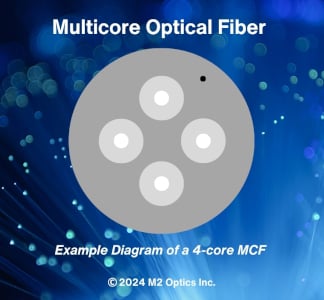An introduction to SDM and multicore optical fibers, an emerging area of technological advancement in the communications market.
More data, more capacity – a frequent statement heard across today’s fiber optic communications arena. This is certainly the mindset of the optical fiber manufacturers, who are tasked with consistently researching and developing new design approaches to meet increasing global demands for bandwidth and data transmission efficiency. Recently, advancements in hollow-core optical fibers (HCF) have been widely publicized, but another emerging technique is Space Division Multiplexing (SDM), achieved using multicore optical fibers (MCF) and few-mode fibers (FMF). This article briefly introduces SDM, focusing on multicore technology and its known advantages, challenges, applications, and a few examples of MCF brands.
Space Division Multiplexing (SDM) – An Introduction
Space Division Multiplexing (SDM) is a design concept intended to increase the amount of data transmitted within an optical fiber, expanding the capacity within cables. Unlike traditional single-core fibers with multiplexing techniques that manage multiple signals using wavelengths or time, SDM exploits the spatial dimension of the fiber, offering multiple spatial channels within a single fiber. This can be achieved in several ways, including using multicore fibers, which contain multiple cores in a single fiber, and few-mode fibers, which support transmission across several modes in a single core. Since MCF and FMF differ in their respective approaches (ie, multiple cores vs multiple modes in a single core), today we’ll highlight MCF and address FMF in a future article.

Advantages of SDM and Multicore Optical Fibers
Designed with the intent of transmitting larger amounts of data more efficiently, space division multiplexing technology offers several primary benefits:
- Greater Transmission Capacity: SDM significantly increases a fiber’s transmission capacity by adding more channels for data transmission, effectively multiplying the throughput. In the case of a multicore fiber, having two cores or four cores instead of just one effectively doubles or quadruples the overall capacity.
- Enhanced Efficiency: By delivering more data within a single fiber via increased capacity, SDM reduces infrastructure costs, as fewer fibers and cables are necessary for the network or data center to achieve intended data goals or thresholds.
- Easier Scalability: Offering more capacity per fiber, SDM offers scalability improvements by enabling incremental upgrades in data capacity, using fewer cables or potentially minimizing the need for additional cables, helping future-proof against growing data demands.
SDM and Multicore Fiber Technology Challenges
Despite the clear benefits that space division multiplexing and multicore fibers offer, this technology has a few technical and manufacturing challenges that people in this space are working to address effectively:
- Design and Manufacturing Complexity: Multicore and few-mode fibers are more complex to design and effectively manufacture, requiring manufacturers to exercise precise control over core spacing and uniformity to minimize crosstalk and modal dispersion characteristics.
- Inter-Core Crosstalk: One of the significant challenges in multicore fibers is inter-core crosstalk, where signal leakage between cores can degrade the quality of data transmission. Thus, the design and construction of these fibers, in terms of proper and consistent core spacing, along with other variables, must minimize crosstalk to optimize transmission performance.
- Advanced Splicing Equipment Requirements: Since multicore fibers require a precision alignment of all cores when splicing two fibers together, traditional single-core fiber splicing machines are insufficient. Therefore, more advanced splicing devices that include rotational alignment capabilities are required. As one might expect, these devices typically demand a significantly higher investment due to their advanced capabilities.
- Cable Breakout, Fanout, and Termination Design Decisions: For those manufacturing multicore fibers and/or offering them in a cabled format for network deployment, questions arise about various approaches for breaking out the individual cores and their respective transmissions from a cabling perspective. What are the best and most efficient methods (from both a manufacturer and user perspective) for transitioning from a single fiber with multiple cores to individual single-core fiber cables? What types of fanouts will be utilized, if any, or will a direct-attach device approach (similar to active optical cables) between equipment be preferred? The list continues, but more clarity should be on the near-term horizon for addressing these challenges.
SDM and Multicore Fiber Communications Applications
Space division multiplexing technology and multicore fibers appear to be a viable solution for any network operators and service providers seeking to expand bandwidth and transmission capabilities more efficiently. A few examples are:
- Data Centers (Inter and Intra)
- Telecom/ISP Backbone Networks
- Submarine and Transoceanic Networks
Multicore Optical Fiber Manufacturers and Brands
Several globally recognized entities in the fiber optic communications market are at the forefront of designing, developing, and manufacturing multicore optical fibers.
- Sumitomo®
- OFS®
- Fujikura®
It should be noted that this is just a partial list of entities manufacturing multicore optical fibers, as there are other entities both large and small developing multicore, few-mode, and other optical fibers within the SDM realm for communications applications.
SDM and MCF - Shaping the Future of Optical Communications
SDM technology and multicore fibers, while still early in their development and deployment lifecycle, represent a promising future in terms of fiber optic communications innovation. Similar to the advancement of any new technology, SDM and multicore fibers (along with few-mode and other fibers in this category) have recognized benefits and technical hurdles that must be overcome if the ultimate goal is mass production and deployment throughout global networks. At this time, it appears to already be gaining acceptance and trending in a positive direction, ultimately positioning the technology to play an essential role in fiber optic networks now and in the near future.






